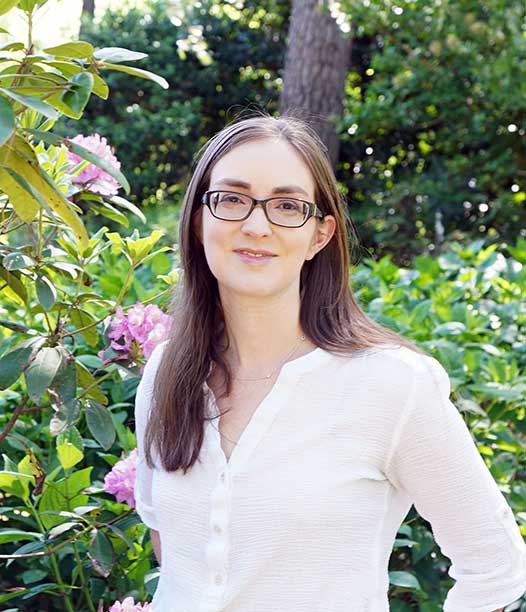Ecologist spreads awareness of climate change by improving science communication
Meet Jordan Bush
What comes to mind when you think of the word “science?” For Jordan Bush, doctorate in ecology and evolutionary biology, science isn’t only about experimenting in the laboratory or conducting field research. Instead, science goes beyond just experimentation. How the scientific community communicates and interacts with the public is just as important as the research behind that communication, and Jordan has been using her fellowship to educate others about climate change.

Jordan Bush uses her passion for science communication to help the communities who need it the most. (Photo Credit: Samantha Collins and Ambar Torres, North Carolina State University)
Jordan knew from the very start that she would grow up to be a biologist. With an early love of animals and nature, biology was the next logical step. So in 2014, she graduated from Trinity University with a bachelor’s of science in biology and bachelor’s of arts in mathematics. Then in 2020, she received her master’s in journalism from the University of Tennessee Knoxville, simultaneously with her doctoral degree in ecology and evolutionary biology.
“While I was at UTK, I started taking science writing courses, where you learn how to tell the stories of science. And I fell in love. And I learned that it is hard to get other people to see things the way you see them, to explain things to people who don’t have the background or interests you do,” she said.
“Helping people understand science – how it effects them, how to use tools and results, how to make informed decisions – is critically important, now more than ever.”
Jordan was appointed to the United States Geological Survey’s (USGS) Science Communications and Translation Postdoctoral Fellowship in 2021. It’s here that she has been putting her dual communication and biology tool sets to good use.
While assisting the communications team with her mentor, Emily Fort, Jordan’s research seeks to help the USGS’s Climate Adaptation Science Centers (CASCs) improve upon the way people interact with science, particularly climate change. Jordan primarily assists the National CASC, the managing entity for the nine regional centers.
Jordan and her team have been looking analytically at the audiences the CASC network connects with. As a federal agency, the CASCs deliver science to a lot of different users, including resource managers in agencies like the National Park Service, Tribal Nations and local communities. Jordan is picking apart CASC outreach materials aimed at different audiences, reviewing everything from their website and social media to physical handouts. She is also collaborating with scientists and experts to develop tailored materials and identify areas of improvement. After her research is finished, Jordan will write an in-depth article outlining best-practices for reaching different audiences in federal agency communications.
She and her team hope their study will help get information on climate change to those who most need it, and in a format that is easy to understand. Her research will help the CASCs discuss climate change with communities that have been, or will be, affected.
Alongside this analysis, Jordan is also just beginning a collaboration with the CASC’s Regional Invasive Species and Climate Change (RISCC) Network. The RISCC Network is a boundary spanning organization that helps connect scientists with resource managers and policy makers. RISCC helps managers understand how climate change is affecting species invasions in their regions and helps state agencies develop “watch lists” for new species that warming temperatures may bring in. Jordan is learning about the different ways these invasive species management agencies operate per state, which she says can vary quite a lot.
“Different states have different land areas they have to manage. Different budgets, different priorities-plants vs animals, ecological vs agricultural pests, etc. Different primary mechanisms and drivers of invasion, e.g. ballast water bringing marine invaders to port cities, fires spreading invasive grasses in Western landscapes, etc,” Jordan explained in detail. “I am qualitatively and quantitatively examining the variation in state invasive species management agencies across different regions.”
She will later be submitting her findings to an academic journal focused on communications or management.
Jordan’s favorite part of her internship is the ability to enhance her writing skills, which she stated has been a lot of fun. She said she wishes others understood that science is just as creative a field as it is analytical.
She ended her interview by praising the ORISE experience and suggesting others apply.
“I would absolutely recommend ORISE to others! I have really enjoyed my time interacting with federal science agencies. While I loved my very academic graduate research, getting to work with science that actually helps people solve real-world problems has been intensely rewarding.”
While experimenting in the lab or field is a big part of being a scientist, Jordan has proven creative thinking and communication with those outside of STEM is just as important. Later this fall, she will be presenting her study at the National Adaptation Forum in a panel called “Diverse Communication Approaches to Reach Diverse Audiences.” After her internship ends, Jordan would like to continue a scientific communications career.
The U.S. Geological Survey Research Participation Program is funded by the USGS National Climate Adaptation Science Center. The Program is administered through the U.S. Department of Energy’s (DOE) Oak Ridge Institute for Science and Education (ORISE). ORISE is managed for DOE by ORAU.


